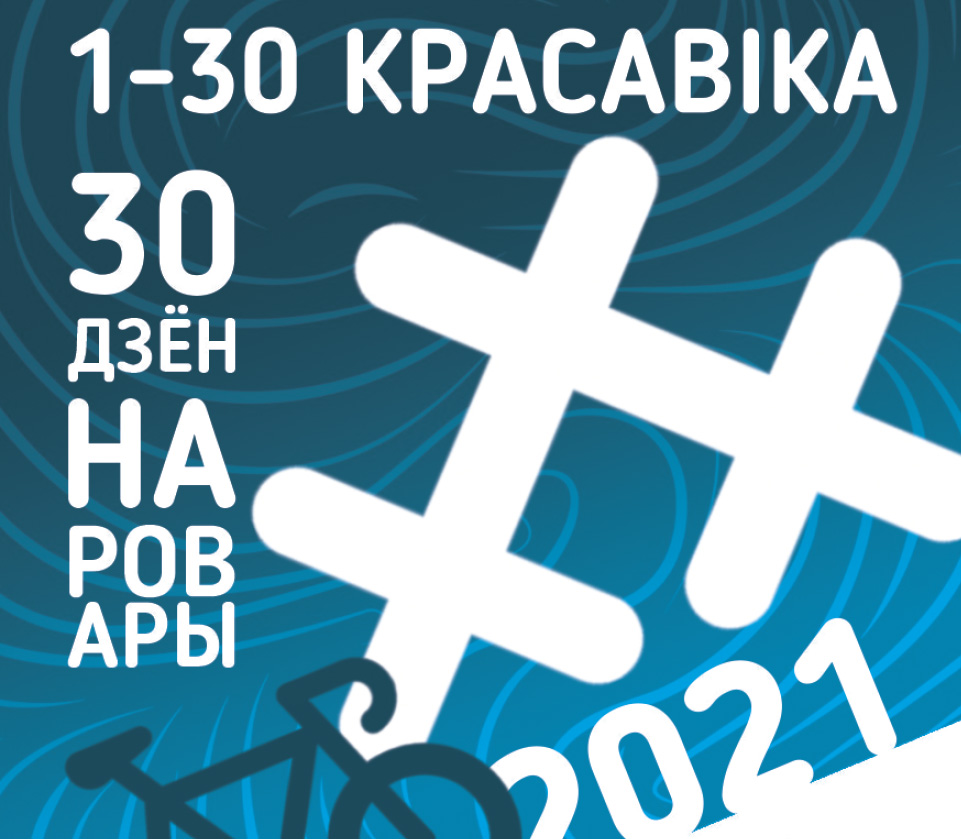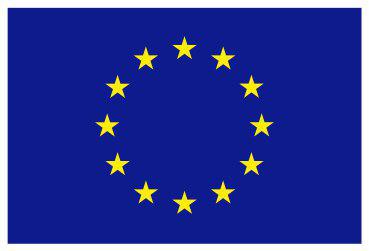The roads of Ukraine have always been criticized by Belarusians, but at the same time, modern solutions for cycling infrastructure appear in cities. Member of the Moscow Military District Maksim Puchinsky talks about what he saw during his summer internship in Ukraine.
The roads of Ukraine have always been criticized by Belarusians, but at the same time, modern solutions for cycling infrastructure appear in cities. Member of the MBO Maxim Puchinsky talks about what he saw during his summer internship in Ukraine.
There are fewer cyclists in Kiev than in Minsk
The bike rides on the road, and this is the main thing to know about the rules for cyclists in Ukraine. If you're unlucky, the infrastructure will consist mostly of bad roads and maybe bike parking.
But, if you're lucky, then about half of the city will be able to drive along modern bike paths with special markings, separate from cars and pedestrians.
If you do not want to drive on the carriageway, then at best the sidewalks will have to be shared with pedestrians, at worst - with parked cars.
All this can be seen in Ukraine, which was done by Maksim Puchinsky, a member of the Minsk Cycling Society, as part of a summer internship under the project “Urban Cycling in Belarus” with financial support from the EU.
Maxim worked with "Association of cyclists of Kiev"Over the organization summer cycling school, took part in organizing bike parade, attended working meetings in Ivano-Frankivsk, Lvov, Mukachevo, Uzhgorod, Vinnitsa and Cherkasy - cities in western and central Ukraine.

First on the list was Kiev. Here it is worth paying attention to the concept of the development of cycling, but it is hardly worth taking an example from the existing infrastructure. Riding is uncomfortable because of broken asphalt or unusual paving stones, on which it shakes, because of the large number of slides into which even locals climb on foot.
- According to the rules, you only need to move along the carriageway. But about a third of cyclists still ride on sidewalks to feel safe. In some places there are paths along the sidewalks, but in Minsk they are made much better. Unlike Kiev, we are already at the design stage solving the problem with high curbs, poles or flower beds on the bike path, says Maxim.
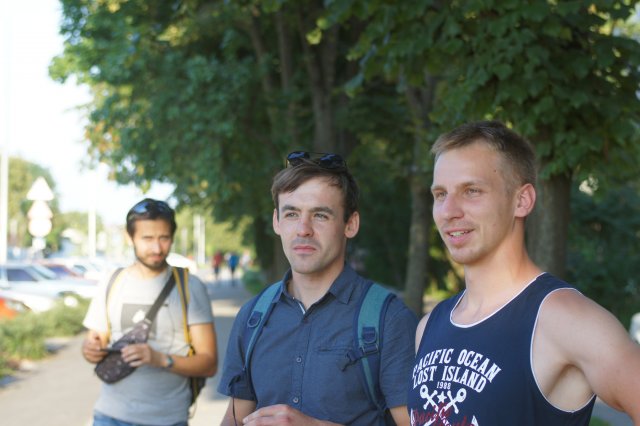
An exception is the new bike path on Grigorenko Avenue, but it is partially parked by cars.
As part of his internship at AVK, Maxim spoke about cycling in Belarus:
“They were surprised by the ban on traffic on the carriageway in Belarus and the fact that we have quite a lot of cyclists: at rush hour, up to 500 people can pass along the bike path along the Svisloch. In Kiev, it is felt that there are fewer of them, as well as in other cities of Ukraine, - he says.
Ivano-Frankivsk and its pedestrian center
In terms of cycling infrastructure, Ivano-Frankivsk and Lviv stand out the most with their integrated and systematic approach.
- Ivano-Frankivsk does a lot to become convenient for cyclists: for example, a large number of pedestrian streets where you can ride a bike and where you can't get there by car, - says Maksim Puchinsky.

Pedestrian street in Ivano-Frankivsk
It is a comfortable and flat city of small size - 5 by 7 km - but inhabited by 200 thousand inhabitants. There is no general scheme of bicycle paths, but there are bicycle paths connecting the outskirts and the center (for example, a bicycle path from the side of the Vishenka district). A long cycle path runs around the city along the river.
The central part of Ivano-Frankivsk is pedestrianized, with lowered borders, greenery and outdoor furniture. Driving a car takes place around it clockwise or by permission. It is limited by bollards.
There are areas near buildings and for pedestrians, delimited from the movement of bicycles and cars. The role of the limiter is played by greenery and outdoor furniture.
 Zoning of space on a street under construction, depending on its use
Zoning of space on a street under construction, depending on its use
This is Galitskaya street, and before it differed little from any wide Soviet street. After the repair, the cycling route along it was laid parallel to the pedestrian part, in places separated by a fence, following it behind or before the stop.

One of the intersections on Galitskaya was made with the help of Dutch experts. The designers managed to bypass almost all the pillars on the path of pedestrians and cyclists. The turning radius is sufficient for the vehicles to slow down. The opposite in this regard is the intersection at Dauman and Masherov, where a smooth and long turn constantly provokes accidents.

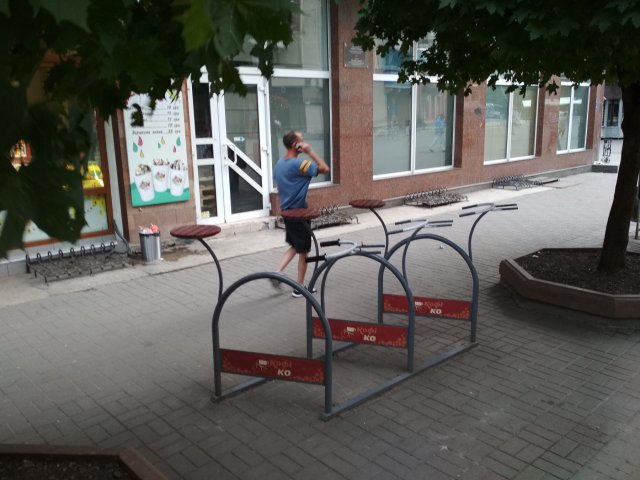
Parking with tables near the cafe

Bicycles in the landscaping inspection
Lviv: cycle rings, pocket for turning left, boulevard
In the new districts of Lviv, bike paths and lanes are being made, and many examples of their implementation can be cited.

New street in Lviv: separate spaces for pedestrians, bicycles, cars and parking
The photographs show individual solutions:
Two-way bike path at the crossing
· Raised intersection to reduce vehicle speed. In Minsk, there are similar intersections with the use of asphalt shields, but the Lviv version, due to the tiles, shows the driver that this is a pedestrian's territory, and not his. In Holland, this is done at the arrivals to the courtyard.
Cycle pocket for priority turning to the left - in a conspicuous place, right in front of the car
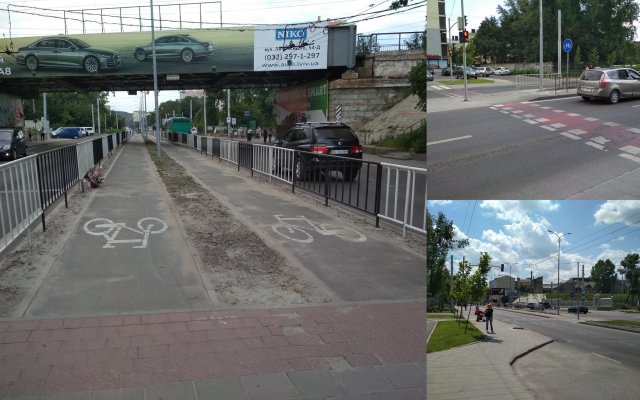
The photos above show the bike path that leads onto the boulevard. It is laid in the center of the carriageway and runs under the bridge for about 100 meters. The reasons are too narrow sidewalks. And it was impossible to make a bike path along the edge of the roadway, moving the lanes to the center, it was impossible - in the center, the main sewer collector of Lvov, the former Poltva river, runs underground.
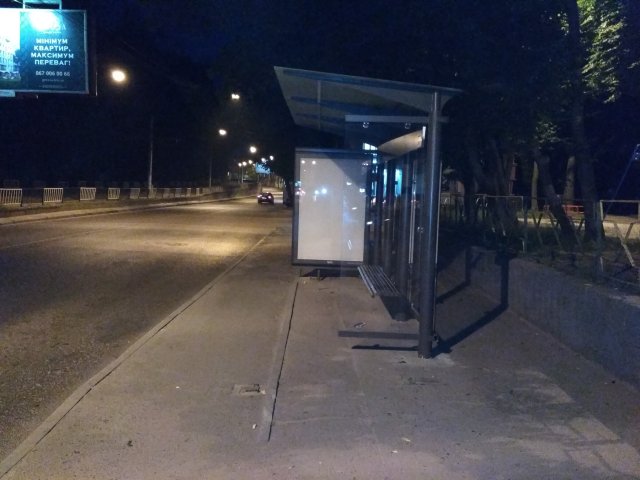
Cycle path before stopping in a pedestrian area
- The cyclist must either go around the bus or wait. Although this was done on the recommendations of German experts, I think this is an example of how not to do it. Waiting decreases the speed of the cyclist, says Maxim.

Another of the reconstructed streets, Lviv
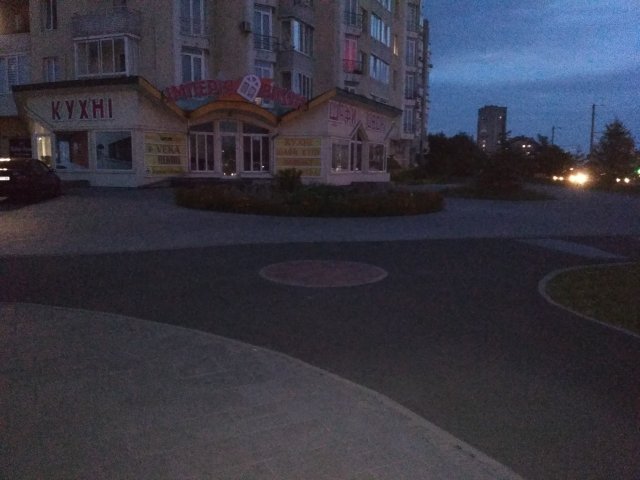
Raised bike ring at the intersection of three bike paths

Fancy parking lots and do-it-yourself station with tools

Bike police
Parked sidewalks of Mukachevo
Most of this city, in terms of population comparable to Molodechno, is occupied by manor buildings, sidewalks are often occupied by cars, and pedestrians move between cars or along the roadway. They are already thinking about the creation of bike paths here, but so far there are vanishingly few of them.
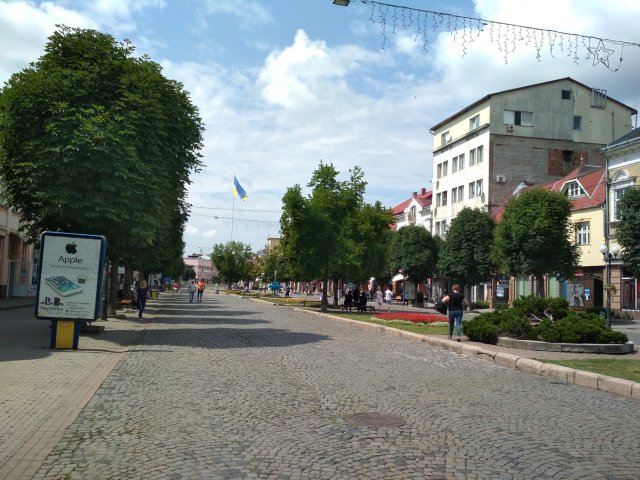
The pedestrian street in Mukachevo is part of a triangular pedestrian zone where pedestrians and cyclists move around. Area - about 1 km2.

The problem of Ukraine is parking, which makes Mukachevo look like Kiev. Cars are not evacuated as this cannot be done without the presence of the driver.
When organizing traffic in Minsk, this problem is solved by the introduction of paid parking zones and control over it, as well as the installation of restrictive small architectural forms. Traffic police control works (including through photographing from the car), but not always due to limited capabilities.
Vinnytsia: bike boulevard, pedestrian layout and absurdity, like at home
Vinnytsia is a large city with a population of almost 370 thousand people. Cycling is very active here, mainly along the carriageway, but in some places along cycle paths. Now they do not form an integral scheme, but from separate districts they lead to the center. There are a lot of bike paths, which means a lot of good and bad. Let's start with examples, some of which you can find in Minsk, and some of which you can't come up with on purpose.
The paths in Vinnitsa often go along the sidewalk and are not always straight: in the photo, the bike path comes to naught, and then reappears. In another photo, half of the visually wide cycle lane is occupied by trees. On the third - a flowerpot, which actualizes the issue of attention on the road.
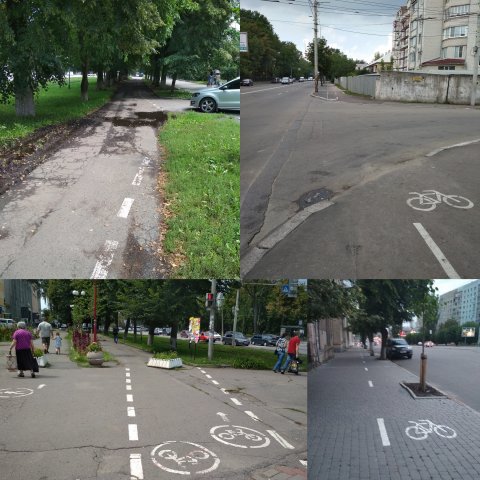
The next solution is unexpected: a path in the park around a flower bed measuring about 10 by 30 meters. Who uses it and why is not very clear.

An exemplary bike path on the boulevard along Kosmonavtov Avenue. The width is 1.5 m, which is not enough, but it has two-way traffic. The intersection with the carriageway is well done: one level, curbs do not interfere, in the middle there is a safety island. In some places, the edges of the path are delimited by concrete hemispheres.

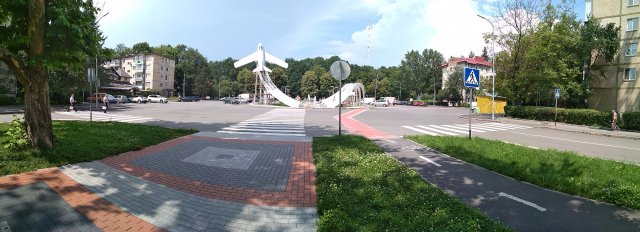
Some of the pedestrian crossings in Vinnitsa are brightly illuminated, and on the sides there is something like a model of a pedestrian. In the city, you can find an alternative to speed bumps - a row of concrete cones, which are not an obstacle for the cyclist.

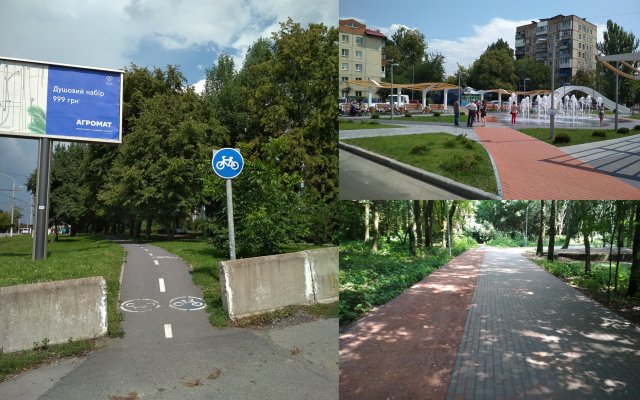
A path made of soil chips in the park, next to it is a tiled path for pedestrians. It is convenient, but requires a carefully planned drainage system.

Otherwise, do not do this: an intersection with a large number of unused asphalt zones
Pedestrians and bicycles will be separated by a buffer zone
How applicable is the Ukrainian experience in Belarus?
- Applicable, but first of all, the experience of Ivano-Frankivsk and Lviv in terms of creating bike lanes and bike paths on the roadway. There were streets that were well executed in terms of separation by materials: granite tiles, ordinary tiles, - says Maksim Puchinsky. “Moreover, Ukraine has now adopted a norm according to which there should be a buffer zone between the zones for pedestrians and cyclists. It can be arranged in the form of a tray with a lower level of the sidewalk so that a person feels that he has left his zone.
The experience of Ukraine is also interesting because we have a similar past. When designing streets, a lot of space is given to cars, although cities, first of all, should be convenient for people.
The material was prepared within the framework of the project “Urban Cycling in Belarus” with the financial support of the European Union.
Text: Anna Volynets
Photo from the archive of Maxim Puchinsky


